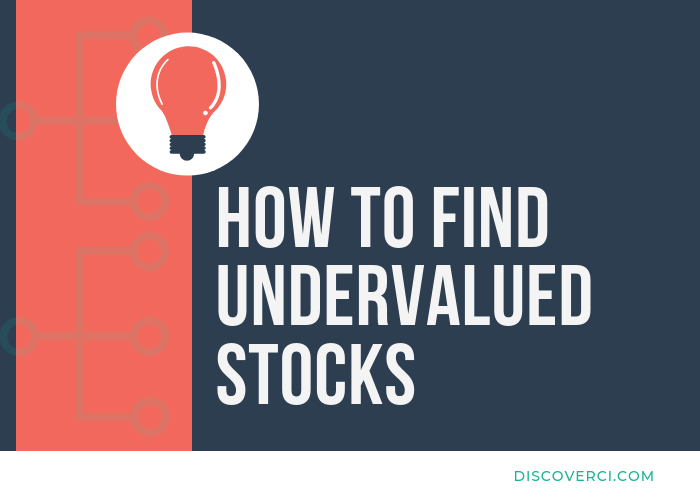Finding undervalued stocks can be a difficult task.
But if it were easy, everyone would be doing it.
Because of this, investors who commit the time and effort needed to find undervalued stocks can realize a high return on their investment.
If you want to find awesome stocks at discount prices, then you’ll love the four quick and simple approaches to finding undervalued stocks in this guide.
Let’s dive right in.
Starting Your Search: The Stock Screeners
The fastest way to narrow down your search for undervalued stocks is to use an advanced stock screener.
You’ll need a screener that you can customize, with fundamental data, like the DiscoverCI Stock Screener.
The screens below are designed to identify stocks with ratios that indicate they may be priced “cheaply” by the market compared to their underlying fundamentals.
There are four main screens that are widely used by value investors to find awesome stocks that are undervalued by the market:
- Price to Book Ratio: Trade stocks with equity values close to, or at a low multiple of book value.
- Price to Earnings Ratio: Trade stocks that are priced at a low multiple of earnings.
- EV/EBITDA Ratio: Trade stocks with low enterprise values compared to EBITDA.
- Dividend Yields: Trade stocks with high dividend yields.
All of the above trading strategies have been back-tested extensively over the years, and are proven to outperform the market if executed correctly.
But there are several traps you need to avoid while using each of these screens.
With that, it’s time to look at each of these screens in greater detail.
Screen #1: Price to Book Value Screen
Book value theoretically represents the total amount a company is worth if you sold all of its assets and paid back all of its liabilities.
The formula to calculate book value is simple:
Book value of a company = Total assets – Total liabilities
Typically, companies trade at higher valuations than their book value.
This is because investors expect them to continue operating and growing shareholder value.
For example, below is Amazon’s (NASDAQ:AMZN) Price to Book Value ratio since 2008:
+Price+to+Book+Value.PNG)
You can see that Amazon’s market price has traded around 20 times it’s book value since 2015.
Before investors realized the potential of Amazon, it was trading at around 10 to 15 times it’s book value.
Now going back to the price to book value screen.
The screen is a quick way to identify companies that the market doesn’t expect to experience high growth going forward.
Why does this represent an opportunity?
Because the general market isn’t always right when it comes to predicting growth. If a company with a low price to book value grows at a faster rate than expected, that could mean it is undervalued right now.
There is no perfect P/BV ratio to use in your screen. It really depends on the industry.
But generally when you’re looking for value, the lower the better.
For example, you could screen for stocks with low price to book values:

And then sort the list of stocks from low to high:

But you can see there are over 3,500 stocks that are included in this list.
That doesn’t give you a great starting point for your research.
A better approach is to include additional criteria to narrow your search, and remove stocks with warning signals.
There are several strengths and weaknesses of the price to book value screen:
Strengths
- High returns if a company outperforms expected growth
- Liquidation value is close to market value
Weaknesses
- Stocks with low price to book values have historically gone out of business at a higher percentage
- Generally low growth companies, with the expectation of slow growth in the future
- The unknown risk factors. Stocks generally trade higher than their book values, so why is this company trading for close to, or less than book value?
To limit the above risks, and return a better list of companies that are potentially undervalued, additional criteria can be added to the P/BV screen:
- TTM Revenue Growth Greater Than 5% (Remove Low Growth Companies),
- Price to Book Ratio Less Than 2,
- Altman Z Score Greater Than 2.75 (Lower Risk of Bankruptcy),
- Outstanding Debt Less Equity (Indicator of Safety), and
- Return on Invested Capital Greater Than 10% (Remove Companies With Low Quality Growth).
With the additional criteria, you can see that a more focused list of stocks is returned:
.PNG)
You can also find the most recent results of this screen here.
Screening for stocks with low price to book value ratios is a great way to find undervalued stocks, but it’s not the only way.
Next up, the price to earnings screen.
Screen #2: Price to Earnings Screen
The price to earnings (P/E) ratio gets a lot of attention from investors.
For good reason.
This ratio is a great metric for benchmarking the equity valuation of a stock, and understanding how the market views a company’s expected growth.
You’re probably familiar with the formula to calculate price to earnings, but just in case:
Price to Earnings = Stock Price / Earnings Per Share
Companies with high P/E ratios are generally classified as growth stocks.
They are considered growth stocks because investors are paying a price per share that is much greater than current earnings.
By screening for stocks with low P/E ratios, you can find companies that would be undervalued if their future earnings growth is higher than the current expected growth.
To start, you could simply screen for stocks with a P/E ratio greater than zero:

And sort from low to high:

This again returns a huge list of companies, and doesn’t provide any additional analysis outside of the price to earnings ratio.
One of the risks of the P/E ratio screen is that it will return companies with very limited growth potential.
Another weakness is that companies with negative earnings aren’t included in the screen.
Let’s add more criteria to make this a more useful screen, and remove companies with higher risk, and low historical growth:
- TTM EBITDA Growth Greater Than 10% (Remove low or no growth companies),
- Price to Earnings Ratio Less Than 10,
- Outstanding Debt Less Equity (Indicator of Safety), and
- Return on Invested Capital Greater Than 10% (Remove Companies With Low Quality Growth).
+Ratios.PNG)
Now that is a decent list of potentially undervalued stocks.
Next up, the EV/EBITDA screen.
Screen #3: Enterprise Value to EBITDA Screen
As discussed earlier, there are weaknesses with using Price to Earnings as a screen for undervalued stocks.
Recently, many investors have argued that using Enterprise Value to EBITDA (Earnings Before Interest, Taxes, Depreciation and Amortization) is a better screening method.
A company’s EV/EBITDA is calculated using the formula:
EV/EBITDA = (Market value of equity + Debt – Cash) / EBITDA
A company’s EV/EBITDA is less impacted by financial leverage, and is focused on EBITDA, which is a better cash flow measure than earnings.
The downside of the EV/EBITDA ratio is it removes taxes, which most investors agree is an ongoing cost of any company.
EBITDA can also cover-up low returns on invested capital, because of the mechanics of adding back Depreciation and Amortization to earnings.
Because of this, when using the EV/EBITDA stock screen, it’s important to include metrics that limit the risk of identifying an underperforming company.
Using our EV/EBITDA stock screener, we scanned for stocks meeting the following criteria:
- TTM EBITDA Growth Over 10%,
- Debt to Equity Ratio Less Than 75%,
- TTM ROIC Greater Than or Equal to 10%, and
- EV/EBITDA Less Than 8.
Which returned a list of 145 stocks meeting these criteria:

Another list of awesome stocks to further analyze!
If none of the first three screens returned stocks that meet your investment criteria, we have one more option...
Screen #4: The Dividend Yield Screen
If you’re an investor looking to add income generating stocks to your portfolio, companies with high dividend yields are a good place to start.
Dividend yield measures a company’s dividend per share as a percentage of it’s stock price:
Dividend Yield = Dividend Per Share / Price Per Share
This ratio is helpful in finding awesome stocks with high dividend payments.
But there is risk with investing in stocks that have high dividend yields, including:
- The dividend may be unsustainable because the company is paying out too much of its free cash flow
- Companies that pay a significant dividend have less cash flow to reinvest and grow future earnings
- Low performing companies may use high dividends to attract anxious investors
Luckily, there are other ratios we can use to remove stocks from our search that contain these warning signs:
Dividend Payout Ratio
Dividend Payout Ratio = Dividends Paid / Net Income
The dividend payout ratio measures how much of a company’s net income is paid out in dividends.
If a company’s dividend payments represent a significant portion of net income, that is a big warning sign that the dividend may not be sustainable.
Debt to Equity Ratio
Debt to Equity Ratio Formula = Total Debt / Total Equity
The debt to equity ratio measures a company’s total debt, relative to its total equity.
Companies with higher debt to equity ratios generally pay a higher cost for capital. They are also more impacted by overall economic changes.
This can be an indicator of greater risk, which makes the debt to equity ratio a useful metric to remove higher debt leveraged stocks from the screen.
These ratios are important metrics to help narrow your search and remove companies that don’t meet your investment requirements.
Our dividend yield stock screen scans the market daily for stocks meeting these requirements:
- Dividend yield greater than 3% (indicates high dividend payments),
- Dividend payout ratio less than 100% (indicates the Company isn’t paying more than 100% of its income in dividends),
- Debt to Equity Ratio less than 1 (more stable companies),
- EPS growth greater than 5% (continuing to grow operations),
- Altman Z Score greater than 2.75 (low risk of insolvency and bankruptcy).
The screen returned 50 stocks with strong dividend yields, and equally strong fundamentals:

Another great list of companies to begin analyzing!
The Stock Screening Template
These four screens are based on valuation measures that help identify whether a stock is over or undervalued.
But by themselves, they have limited use.
We covered the weaknesses of each of these ratios, but it’s worth repeating - if a stock has low valuation ratios, there may be a good reason for it.
That’s why including additional metrics in your screen, and analyzing each stock in greater detail before investing is a key step in finding undervalued stocks.
Our four screens are based on a screening approach, which you can also use in your search for awesome stocks:
- Screen for cheap stocks: Start by using a ratio that identifies stocks that are “cheap” (P/BV, P/E, EV/EBITDA).
- Search for stocks with low risk: We used the Altman Z Score and the Debt/Equity ratio in our screens, but you can use other ratios and metrics that accomplish the same goal (i.e., beta, standard deviation, etc..).
- Find growing stocks: Stocks that appear cheap have a higher risk of slow future growth. Look for stocks with a recent history of growth, or a competitive advantage that you believe will lead to future growth.
- Identify quality indicators: You’re looking for well-managed stocks ready to grow and provide a ton of shareholder value. Remove companies that don’t meet this criteria. You can use a return on invested capital ratio, or another ratio that measures growth quality.
With practice and patience, you’ll soon find the screening criteria that works best for your unique investment strategy over the long term.
Now It’s Your Turn
Finding stocks that generate a high return on investment is the number one goal of every investor.
Identifying stocks with low market prices compared to their intrinsic value, and holding them for the long term is one way to achieve this goal.
For more tips on how you can take your stock analysis to the next level, check out our posts covering fundamental analysis and how to find the intrinsic value of a stock.
Or
Use our intrinsic value calculator to calculate a stock's value using the Ben Graham formula.
We hope this guide gives you the tools you need to find your next investment.
Good luck!







